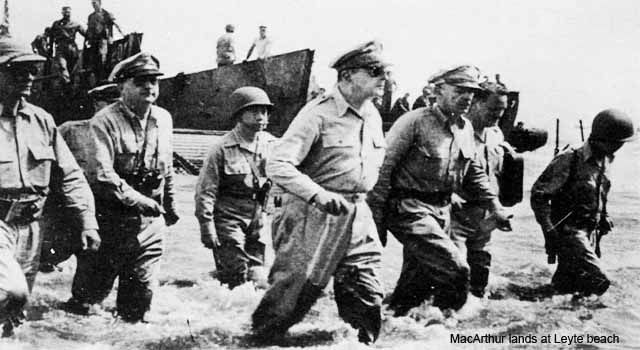|
The ensuing battle for Leyte island easily pushed the indigenous guerilla movement out of the limelight. Compared to the Japanese and American forces, Filipino guerillas were outnumbered and too ill equipped to really play any significant roles, except as guides or scouts.
There was however no doubt about their courage and will to fight. Even MacArthur himself later acknowledged the valuable roles guerillas played in the subsequent battles between the Americans and Japanese troops in Leyte.
Leyte in 1944 was not exactly an ideal place to begin an invasion. From the military standpoint, the island looked deceptively attractive. Some of the best landing beaches in the Pacific are said to be found here. "But once an invader got beyond the beaches, he is faced with swamps, rice paddies, innumerable streams, and a general sponginess underfoot", an American writer observed.
Bad weather in October added misery to the would-be invader. Rain-soaked roads turned into mudpools that could easily entrap military vehicles and hinder movement. If this was bad for the Japanese troops already entrenched here, it was even worse to the incoming American soldiers who would step on its shores for the first time.
Warnings aired by an American engineer Col. William J. Ely before the US military high command proved futile. His suggestions to put in more engineer construction troops to Leyte could not be taken up for they were simply not available. Despite these objections, the risk had to be taken. It had to be Leyte.
The decision in mid-September to invade Leyte two months earlier than originally scheduled only increased the dangers involved.
October was the worst part of the year's rainy season, the time when most typhoons from the Pacific visited the island.
On the other hand, the Japanese were themselves not in the best fighting form either. For the Filipino guerillas with their single-shot latong ( homemade guns from GI pipes), the Japs were a formidable force. But to forces steeped in battles, the Japanese units in Leyte suffered from several deficiencies.
Gen. Shiro Makino
Leyte's defenses in October 1944 were handled by Lt. Gen. Shiro Makino of the 16th Division. Under him were 20,000 foot soldiers, which included attached service and naval guard troops. This force was one-fifth of Gen. Suzuki's 35th Army responsible for defending all of central and southern Philippines.
The 16th Division, though one of the earliest to arrive in the country, was relatively weak. Many of Makino's troops were inadequately trained, and at least one regiment was only recently transferred to Leyte. They still had to familiarize themselves with its treacherous terrain.
On top of this, it was still incomplete. "Only the first line of positions, facing the Leyte Gulf around Dulag, was anywhere near finished", said one writer."This position guarded most of Leyte's airfields...and faced that section where they expected MacArthur to land."
|
THERE were no coastal defenses around Tacloban because none of the Japanese officials thought MacArthur would take that risk of deploying their ships in the narrow waters of San Pedro Bay. But then the Japs had other plans. According to their Sho-1 plan, their air and naval forces would engage the American invaders in decisive battles, before they could establish a beachhead. Hopefully, there would be little left of the American troops for the 16th Division to handle.
That plan was based on the Japs' assumption that the battle earlier fought in Formosa was victorious for them. Unfortunately, the reverse was true. The air and naval forces available for defending their territories were pitifully small compared to those of the Americans.
Japanese Hardware
Military historians estimate that the Japanese only had 150 operational planes of all types in the Philippines on the eve of MacArthur's invasion, although Admiral Fukudome in Formosa had about 300 naval aircraft ready to shift their operations if needed. Admiral Ozawa likewise had about 100 carrier aircraft being flown by inexperienced pilots anchored in the Inland Sea.
Japanese naval forces in its First Mobile Fleet had more promise. Admiral Kurita's First Striking Force had seven battleships, eleven heavy cruisers, two light cruisers and nineteen destroyers.
Ozawa's main force was something of a curiosity. It had very few planes, one large carrier, three light carriers, two battleships partially converted into carriers, three light cruisers, eight destroyers and fourteen submarines. At that time, these were anchored in the Inland Sea, awaiting instructions from higher authorities in Japan. Sho-1 would not be activated without orders from central headquarters.
Japanese command structure in the Philippines was likewise confusing, a weakness that worked to the Americans' advantage. The Army ground commander in the Philippines was General Yamashita, having under him the Fourteenth Area army. But he exercised no authority over General Tominaga's Fourth Air Army. Both officers were said to report to Marshal Terauchi, the Southern Army Commander who was also responsible for the Southwest Pacific.
Terauchi however did not have any authority over the naval forces which were under Admiral Toyoda's Combined Fleet. The First Mobile Fleet, though operating in the Philippine waters, was under Vice-Admiral Gunichi Mikawa's Southwest Area Fleet. Toyoda was supposed to coordinate all the various Japanese naval units --surface, undersea and air - taking part in the Sho operation. Terauchi on the other hand was responsible for the major army units involved.
Coordinating the two was not a single unified command in Japan but two separate headquarters, an army command and a navy command, which did not seem too keen on unified actions. Suck lack of coordination would prove fatal in many cases.
|
